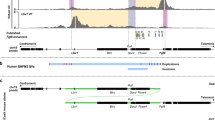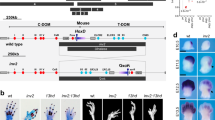Abstract
DiGeorge syndrome is characterized by cardiovascular, thymus and parathyroid defects and craniofacial anomalies, and is usually caused by a heterozygous deletion of chromosomal region 22q11.2 (del22q11) (ref. 1). A targeted, heterozygous deletion, named Df(16)1, encompassing around 1 megabase of the homologous region in mouse causes cardiovascular abnormalities characteristic of the human disease2. Here we have used a combination of chromosome engineering and P1 artificial chromosome transgenesis to localize the haploinsufficient gene in the region, Tbx1. We show that Tbx1, a member of the T-box transcription factor family, is required for normal development of the pharyngeal arch arteries in a gene dosage-dependent manner. Deletion of one copy of Tbx1 affects the development of the fourth pharyngeal arch arteries, whereas homozygous mutation severely disrupts the pharyngeal arch artery system. Our data show that haploinsufficiency of Tbx1 is sufficient to generate at least one important component of the DiGeorge syndrome phenotype in mice, and demonstrate the suitability of the mouse for the genetic dissection of microdeletion syndromes.
This is a preview of subscription content, access via your institution
Access options
Subscribe to this journal
Receive 51 print issues and online access
$199.00 per year
only $3.90 per issue
Buy this article
- Purchase on Springer Link
- Instant access to full article PDF
Prices may be subject to local taxes which are calculated during checkout




Similar content being viewed by others
References
Scambler, P. J. The 22q11 deletion syndromes. Hum. Mol. Genet. 9, 2421–2426 (2000).
Lindsay, E. A. et al. Congenital heart disease in mice deficient for the DiGeorge syndrome region. Nature 401, 379–383 (1999).
O'Donnell, H., McKeown, C., Gould, C., Morrow, B. & Scambler, P. Detection of an atypical 22q11 deletion that has no overlap with the DiGeorge syndrome critical region. Am. J. Hum. Genet. 60, 1544–1548 (1997).
Amati, F. et al. Atypical deletions suggest five 22q11.2 critical regions related to the DiGeorge/velo-cardio-facial syndrome. Eur. J. Hum. Genet. 7, 903–909 (1999).
McQuade, L. et al. Patient with a 22q11.2 deletion with no overlap of the minimal DiGeorge syndrome critical region (MDGCR). Am. J. Med. Genet. 86, 27–33 (1999).
Ramirez-Solis, R., Liu, P. & Bradley, A. Chromosome engineering in mice. Nature 378, 720–724 (1995).
Su, H., Wang, X. & Bradley, A. Nested chromosomal deletions induced with retroviral vectors in mice. Nature Genet. 24, 92–95 (2000).
Puech, A. et al. Normal cardiovascular development in mice deficient for 16 genes in 550 kb of the velocardiofacial/DiGeorge syndrome region. Proc. Natl Acad. Sci. USA 97, 10090–10095 (2000).
McKusick, V. On Line Mendelian Inheritance in Man http://www3.ncbi.nlm.nih.gov/Omim/ (2000).
Gong, L., Liu, M., Jen, J. & Yeh, E. T. GNB1L, a gene deleted in the critical region for DiGeorge syndrome on 22q11, encodes a G-protein beta-subunit-like polypeptide(1). Biochim. Biophys. Acta 1494, 185–188 (2000).
Chapman, D. L. et al. Expression of the T-box family genes, Tbx1–Tbx5, during early mouse development. Dev. Dyn. 206, 379–390 (1996).
Chieffo, C. et al. Isolation and characterization of a gene from the DiGeorge chromosal region homologous to the mouse Tbx1 gene. Genomics 43, 267–277 (1997).
Smith, J. Brachyury and the T-box genes. Curr. Opin. Genet. Dev. 7, 474–480 (1997).
Bamshad, M. et al. Mutations in human TBX3 alter limb, apocrine and genital development in ulnar-mammary syndrome. Nature Genet. 16, 311–315 (1997).
Basson, C. T. et al. Mutations in human TBX5 cause limb and cardiac malformation in Holt-Oram syndrome. Nature Genet. 15, 30–35 (1997).
Li, Q. Y. et al. Holt-Oram syndrome is caused by mutations in TBX5, a member of the Brachyury (T) gene family. Nature Genet. 15, 21–29 (1997).
Kirby, M. L., Hunt, P., Wallis, K. & Thorogood, P. Abnormal patterning of the aortic arch arteries does not evoke cardiac malformations. Dev. Dyn. 208, 34–47 (1997).
Begbie, J., Brunet, J. F., Rubenstein, J. L. & Graham, A. Induction of the epibranchial placodes. Development 126, 895–902 (1999).
Matzuk, M. M., Finegold, M. J., Su, J. G., Hsueh, A. J. & Bradley, A. Alpha-inhibin is a tumour-suppressor gene with gonadal specificity in mice. Nature 360, 313–319 (1992).
Baldini, A. & Lindsay, E. A. Mapping human YAC clones by fluorescence in situ hybridization using Alu-PCR from single yeast colonies. Methods Mol. Biol. 33, 75–84 (1994).
Botta, A., Lindsay, E. A., Jurecic, V. & Baldini, A. Comparative mapping of the DiGeorge syndrome region in mouse shows inconsistent gene order and differential degree of gene conservation. Mamm. Genome 8, 890–895 (1997).
Galili, N. et al. A region of mouse chromosome 16 is syntenic to the DiGeorge, velocardiofacial syndrome minimal critical region. Genome Res. 7, 17–26 (1997).
Puech, A. et al. Comparative mapping of the human 22q11 chromosomal region and the orthologous region in mice reveals complex changes in gene organization. Proc. Natl Acad. Sci. USA 94, 14608–14613 (1997).
Sutherland, H. F., Kim, U. J. & Scambler, P. J. Cloning and comparative mapping of the DiGeorge syndrome critical region in the mouse. Genomics 52, 37–43 (1998).
Lund, J. et al. Sequence-ready physical map of the mouse chromosome 16 region with conserved synteny to the human velocardiofacial syndrome region on 22q11.2. Mamm. Genome 10, 438–443 (1999).
Albrecht, U., Eichele, G., Helms, J. A. & Lu, H. C. in Molecular and Cellular Methods in Developmental Toxicology (ed. Daston, G. P.) 23–48 (CRC, New York, 1997).
Acknowledgements
We thank R. Behringer and P. Hastings for discussions and reading of the manuscript, and Y.-C. Cheah, S. Carattini-Rivera, G. C. Schuster, S.-S. Cheah and C. Roberts for technical contributions. A.B. is an investigator with the Howard Hughes Medical Institute. This work was funded in part by grants from the National Heart, Lung and Blood Institute and (to A.B.), from the American Heart Association Texas Affiliate (to E.A.L.), and from the British Heart Foundation and Wellcome Trust (to P.J.S.). Support from the Baylor Mental Retardation Research Center is also acknowledged.
Author information
Authors and Affiliations
Corresponding author
Rights and permissions
About this article
Cite this article
Lindsay, E., Vitelli, F., Su, H. et al. Tbx1 haploinsufficiency in the DiGeorge syndrome region causes aortic arch defects in mice. Nature 410, 97–101 (2001). https://doi.org/10.1038/35065105
Received:
Accepted:
Issue Date:
DOI: https://doi.org/10.1038/35065105
This article is cited by
-
Aberrant Subclavian Artery in Interrupted Aortic Arch with Severe Aortic Outlet Obstruction: Cerebral Blood Flow as a Possible Determinant of Embryonic Cardiovascular Development?
Pediatric Cardiology (2024)
-
Single-cell transcriptomics uncovers a non-autonomous Tbx1-dependent genetic program controlling cardiac neural crest cell development
Nature Communications (2023)
-
Chromatin regulators in the TBX1 network confer risk for conotruncal heart defects in 22q11.2DS
npj Genomic Medicine (2023)
-
Identification and characterisation of spontaneous mutations causing deafness from a targeted knockout programme
BMC Biology (2022)
-
Prenatal sonographic and cytogenetic/molecular findings of 22q11.2 microdeletion syndrome in 48 confirmed cases in a single tertiary center
Archives of Gynecology and Obstetrics (2022)
Comments
By submitting a comment you agree to abide by our Terms and Community Guidelines. If you find something abusive or that does not comply with our terms or guidelines please flag it as inappropriate.



